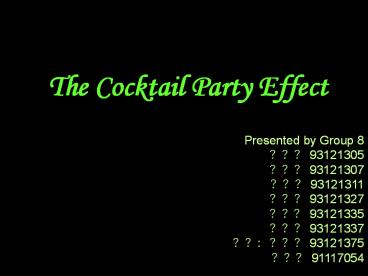The Cocktail Party Effect - PowerPoint PPT Presentation
Title: The Cocktail Party Effect
1
The Cocktail Party Effect
- Presented by Group 8
- ??? 93121305
- ??? 93121307
- ??? 93121311
- ??? 93121327
- ??? 93121335
- ??? 93121337
- ????? 93121375
- ??? 91117054
2
The Cocktail Party Effect
- The Inventor
- Definition
- Cause
- Auditory System
- Recognition of Speech With One and Two Ears
- Source Separation
- Automatically Recognizing Streams
- Conclusion and Games
3
The Inventor of The Cocktail Effect
- Colin Cherry
- 1953
- Air traffic controllers
- 1950's
4
About The Experiment
- Separate two sounds from a single loudspeaker at
the same time - gender, direction, speed, pitch
5
Broadbents Filter Theory
- Our mind can be conceived as a radio receiving
many channels at once - Which channel we should pay attention ?
6
The Cocktail Party Effect
- The ability to focus one's listening attention on
a single talker among a mixture of conversations
and background noises, ignoring other
conversations.
7
When Does The Cocktail Party Phenomenon Occur?
- 1.When we are paying attention to one of the
sounds around us. - 2.When it is invoked by a stimulus which grabs
our attention suddenly. - three times louder than the ambient noise.
8
Cause
Cause
- There is a filter in our brain which can select
which message we should pay attention to. - Ex. If someone call your name in the other side
of the party room calls out your name, we can
notice that sound and response it immediately.
9
Auditory System The Sensory System For The Sense
of Hearing
- Outer ear, Middle ear, Inner ear
- Two ears can identified the location of the sound
limit 20 Hz to 15kHz.distinquish less than 1.5
Hz - The auditory system filters sounds received,
ignores background noise and concentrate on
important information - Ex. mothers to the cries of her baby.
- The ear can differentiate quite subtle sound
changes and familiar sounds.
10
Recognition of Speech With One and Two Ears
- Different directions
- Lip-reading, gestures, and the like
- Different speaking voices
- Different accents
- Transition probabilities
11
Recognition of Speech With One and Two Ears
- No difficulty in listening to one ear
- A slight delay
- Temporary memory
12
Source Separation
- Source separation problems in digital signal
processing are those in which several signals
have been mixed together and the objective is to
find out what the original signal were. - Principal Components Analysis (PCA)
- Independent Components Analysis (ICA)
13
Automatically Recognizing Streams
- It is generally difficult to find tractable and
accurate computational solutions to recognition
problems than human find simple. - Evidence-partition process
- Experiment in 1971

